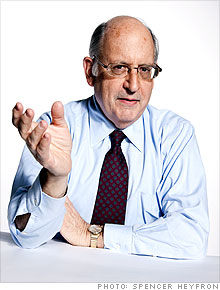(Fortune) -- I get plenty of things wrong, as I tell people in my almost annual mea culpa columns. But every once in a while, I get something right -- as I did in the column I wrote a year ago about the record loss in the value of the Fortune 500's stocks. "Someday," I wrote, "possibly for the 2010 Fortune 500, the stock market will be on a roll again."
As indeed it is. This year the 500 companies' shares had their biggest rise in both dollar and percentage terms since we began doing market-value calculations in the 1980s. That's the polar opposite of last year, when the 500 had their biggest losses in dollars and percentage.
 |
| Allan Sloan, senior editor at large |
About a year ago, you may recall, many people were bailing out of stocks and heading for the hills, on the assumption that the rebound from early-March lows was temporary. That turned out to be a really bad mistake.
Watching all these reversals -- record losses followed by record gains, followed by who knows what? -- is fascinating, provided that you have strong nerves and enough financial staying power to wait for the world to head your way. Oh, yes -- it also helps if you like roller coasters, because these have been roller-coaster years.
This year the market value of the publicly traded members of America's corporate elite rose by $3.3 trillion, a whopping 46%. That topped the previous top dollar ($2.8 trillion, in 2004) and percentage (42%, in 1998) years.
One reason our past two years have shown such violent swings is that we measure market value as of late March. That put us close to the market trough in 2009, which made both last year's decline and this year's rise more dramatic than they would have been if we had used calendar years, on which most of our statistics are based.
The good news for investors, of course, is that the market values of our 462 companies -- the other 38 are privately held -- are up so sharply. The bad news is that even with this record increase, the 500's market value gained less than the $4.1 trillion that it lost last year.
The value of our companies' stock is still down 17% from the record high of two years ago. Even worse, it's lower than it was 10 years ago. This gives you an idea of how awful the stock market has been since the Internet-telecom bubble burst in March 2000.
What lessons can we take from this horrible long-term record? In many ways, the same lessons we talked about last year, the chief one of which is that today's investors can't entrust their long-term financial fate to the stock market on the assumption that stocks will produce substantial returns over time.
The idea that stocks are the average investor's friend took root in the 1980s and 1990s, when stocks went up and up and up. People of my generation -- I'm 65 -- benefited hugely from the greatest bull market in U.S. stock history, an 18-year period (from August 1982 to March 2000) in which the Standard & Poor's 500 index returned about 20% a year, compounded. (I can't give you the Fortune 500 return for that period, because we're not set up for heavy analytics, as the S&P and the Wilshire 5000 are.)
But given today's stock prices (which are near or above historical norms relative to profits) and dividends (low by historical norms), there's no way that today's investors will see anything approaching 20% a year for an extended period the way investors of my generation did. The numbers just don't work, unless you think the Dow's going to be 170,000 or so in 2030.
This past year notwithstanding, the long-term decline in stocks, combined with the huge drop of homeowners' equity values in recent years, means that people are less wealthy than they were.
And that some baby boomers who felt comfortable about their retirement prospects in 2006 and 2007, with stocks and home values both booming, are more concerned with Social Security's outlook than they ever expected to be. And Social Security, as I wrote in February, is running its first cash deficit since 1983. It will still pay benefits, but I think higher-income retirees will see benefits trimmed below the current formula. Possibly way below.
So there you go. If I'm wrong about stocks' long-term prospects, I'll be the first to tell you. Look for my 2031 mea culpa column. ![]()






| Company | Price | Change | % Change |
|---|---|---|---|
| Ford Motor Co | 8.29 | 0.05 | 0.61% |
| Advanced Micro Devic... | 54.59 | 0.70 | 1.30% |
| Cisco Systems Inc | 47.49 | -2.44 | -4.89% |
| General Electric Co | 13.00 | -0.16 | -1.22% |
| Kraft Heinz Co | 27.84 | -2.20 | -7.32% |
| Index | Last | Change | % Change |
|---|---|---|---|
| Dow | 32,627.97 | -234.33 | -0.71% |
| Nasdaq | 13,215.24 | 99.07 | 0.76% |
| S&P 500 | 3,913.10 | -2.36 | -0.06% |
| Treasuries | 1.73 | 0.00 | 0.12% |
|
Bankrupt toy retailer tells bankruptcy court it is looking at possibly reviving the Toys 'R' Us and Babies 'R' Us brands. More |
Land O'Lakes CEO Beth Ford charts her career path, from her first job to becoming the first openly gay CEO at a Fortune 500 company in an interview with CNN's Boss Files. More |
Honda and General Motors are creating a new generation of fully autonomous vehicles. More |
In 1998, Ntsiki Biyela won a scholarship to study wine making. Now she's about to launch her own brand. More |
Whether you hedge inflation or look for a return that outpaces inflation, here's how to prepare. More |